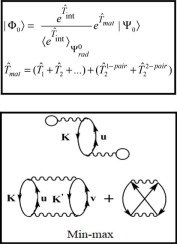Computational and Theoretical Chemistry ( IF 3.0 ) Pub Date : 2019-09-11 , DOI: 10.1016/j.comptc.2019.112574 Sambhu N. Datta

|
An electrodynamical coupled cluster (CC) methodology that is based on the standard QED Hamiltonian written using the Dirac-Fock picture of matter fields and Coulomb gauge is discussed here. It employs the combination of a radiative cluster, a pure matter cluster and its pair modification, and relies on the customary CC approach. Averaging over the radiation state is done first, and the cluster operator for radiative effects leads to Lamb, Breit and hyperfine interactions. Relativistic correlation effects are determined next while using the matter cluster in the traditional way of CC. When the matter cluster is extended to include deexcitations to negative-energy levels, vacuum polarization effects are generated from the pair part of Coulomb interaction. The resulting ground state correlation energy includes both relativistic and QED corrections, the latter including Lamb, Breit, hyperfine and pair energy contributions. The many-electron part of the theory is formulated here for closed shell species.
中文翻译:

基于量子电动力学的耦合簇理论:封闭壳的方法
本文讨论了一种电动力学耦合簇(CC)方法,该方法基于使用物质场的Dirac-Fock图片和库仑规编写的标准QED哈密顿量。它采用了辐射团簇,纯物质团簇及其对修饰的组合,并依赖于常规CC方法。首先对辐射状态进行平均,并且辐射效应的群集算子会导致Lamb,Breit和超精细相互作用。接下来,在以传统CC方式使用物质簇的同时,确定相对论相关效应。当物质簇扩展到包括去激发到负能级时,从库仑相互作用的成对部分产生真空极化效应。产生的基态相关能量包括相对论和QED校正,后者包括Lamb,Brei,超精细和配对能量贡献。该理论的多电子部分在这里针对封闭的壳物种进行了阐述。











































 京公网安备 11010802027423号
京公网安备 11010802027423号